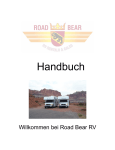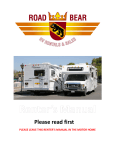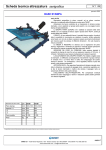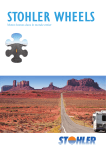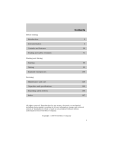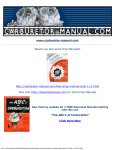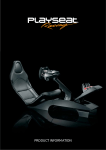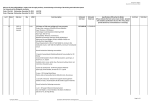Download Road Bear RV Class A Specifications
Transcript
Manual Welcome to Road Bear RV Table of contents 1. 1.1. 1.2. 1.2.1. 1.2.2. 1.2.3. 1.2.4. 1.2.5. 1.3. 1.4. 1.5. 1.6. 1.7. 1.8. 1.9. 1.10. 1.11. 2. 2.1. 2.2. 3. 3.1. 3.2. 3.3. 3.4. 3.5. 3.6. 3.6.1. 3.6.2. 3.6.3. 3.6.4. 3.6.5. 3.6.6. 3.6.7. 3.6.8. 3.7. 3.7.1. 3.7.2. 3.7.3. 3.7.4. 3.7.5. 3.7.6. 3.7.7. 3.8. GENERAL INFORMATION _________________________________________ 4 LOCATION INFORMATION ________________________________________ 5 STATION MAPS _________________________________________________ 6 LOS ANGELES, AGOURA HILLS, CA (LAX) __________________________ 6 SAN FRANCISCO, HAYWARD, CA (SFO) ____________________________ 7 LAS VEGAS, LAS VEGAS, NV (LAS) ________________________________ 8 DENVER, COMMERCE CITY, CO (DEN) ______________________________ 9 NEW YORK, MIDDLETOWN, NJ (NYC)______________________________ 10 SAFETY ______________________________________________________ 11 ACCIDENT ____________________________________________________ 12 BREAKDOWN _________________________________________________ 12 FLAT TIRE_____________________________________________________ 12 MAINTENANCE ________________________________________________ 12 REPAIR _______________________________________________________ 12 DROP-OFF ____________________________________________________ 12 MEASUREMENT CONVERSIONS__________________________________ 13 SPECIFICATIONS_______________________________________________ 14 CAMPGROUNDS _______________________________________________ 15 ARRIVING AT THE CAMPSITE ____________________________________ 16 WHEN LEAVING THE CAMPSITE __________________________________ 16 THE CABIN ____________________________________________________ 17 FORD CABIN (CHASSIS)_________________________________________ 17 CHEVROLET CABIN (CHASSIS)___________________________________ 17 THE MOTOR HOME CLASS C (P-MODEL SHOWN) ___________________ 19 THE MOTOR HOME CLASS C (S-MODEL SHOWN) ___________________ 20 THE MOTOR HOME CLASS A (U-MODEL SHOWN) ___________________ 21 ELECTRICAL SYSTEM __________________________________________ 22 MONITOR PANEL_______________________________________________ 23 GENERATOR __________________________________________________ 24 ROOF AIR CONDITIONER ________________________________________ 25 MICROWAVE __________________________________________________ 25 CONVECTION MICROWAVE ______________________________________ 25 TV / DVD PLAYER ______________________________________________ 26 CARBON MONOXIDE DETECTOR _________________________________ 26 SMOKE DETECTOR_____________________________________________ 26 L.P. GAS SYSTEM ______________________________________________ 27 L.P. GAS DETECTOR ____________________________________________ 27 REFRIGERATOR / FREEZER _____________________________________ 27 REFRIGERATOR – DOMETIC _____________________________________ 27 REFRIGERATOR – NORCOLD ____________________________________ 28 STOVE TOP AND OVEN _________________________________________ 28 FURNACE _____________________________________________________ 29 WATER HEATER _______________________________________________ 29 PLUMBING SYSTEM ____________________________________________ 30 2 3.8.1. 3.8.2. 3.8.3. 3.8.4. 3.9. 3.10. 4. 4.1. 4.2. 4.3. 4.4. 5. FRESH WATER_________________________________________________ WASTE WATER ________________________________________________ TOILET _______________________________________________________ SHOWER _____________________________________________________ SLIDE-OUT ROOM ______________________________________________ AWNING ______________________________________________________ TROUBLESHOOTING ___________________________________________ ELECTRICAL SYSTEM __________________________________________ GAUGES & INSTRUMENTS ______________________________________ L.P. GAS SYSTEM ______________________________________________ PLUMBING SYSTEM ____________________________________________ DISCLAIMER __________________________________________________ 3 30 31 32 32 33 34 36 36 37 38 39 40 1. General information Introduction Thank you for choosing Road Bear RV - the company with the newest rental fleet in the United States. Are you ready to take off with your motor home to explore North America? If your personal walk-through was overwhelming or just too much information, please take a few minutes and read this manual carefully. Familiarize yourself with the vehicle. This will assure that you get the full use of your motor home. We at Road Bear RV are committed to make your vacation as fun and trouble-free as possible. In the event of unanswered questions or an unforeseen malfunction please call our Roadside assistance number. Please leave this manual in the motor home. Lost manuals are subject to a charge upon return. Based on the changes in models from year to year, we cannot precisely describe every motor home individually, but the systems and functionality are very similar if not the same. We provide this manual as a guide. Please read the following information thoroughly. It will help you to avoid problems. Enjoy your vacation! In case of a technical problem or an accident please call our toll free Roadside assistance / Emergency Number 1-888-832-4080 Please have your vehicle ID ready. It is located on your key tag or sun visor. 4 1.1. Location information STATION ADDRESS LISTING 2007-2008 International customers should call the rental station immediately upon arrival but no later than between 8 am and 10 am of the departure day to schedule the pick up. Pick up shuttle transfer time is between 12 - 1 pm. Motor home pick up time is between 1 - 4.30 pm. Motor home drop-off time is between 8 am - 11am. The shuttle leaves at 11 am to airport or airport hotel. There are no more shuttle transfers after 11 am. LAX (Los Angeles) 28404 Roadside Drive Agoura Hills CA 91301 Tel: 1 (818) 865-2925 Toll free: 1-888-832-4080 Fax: 1 (818) 991-2744 Email: [email protected] Sales tax: 8.25% SFO (San Francisco) 847 Industrial Parkway West Hayward, CA 94544 Tel: 1 (510) 247-1119 Toll free: 1-866-249-1119 Sales tax: 8.75% LAS (Las Vegas) 4730 Boulder Hwy Las Vegas, NV 89121 Tel: 1 (702) 453-1109 Toll free: 1-866-303-1057 Sales tax: 7.75% DEN (Denver) 7685 Dahlia Street Commerce City, CO 80022 Tel: 1 (720) 570-1100 Toll free: 1-866-457-1100 Sales tax: 4.85% NYC (New York) 42 Highway 36 Middletown, NJ 07748 Tel: 1 (732) 495-0959 Toll free: 1-866-787-3682 Sales tax: 7.00% Business Hours: Mo – Fr. Sa. Sundays & Holidays 8:00 AM – 5:00 PM 8:00 AM – 1:00 PM (longer during season) closed 5 1.2. Station Maps 1.2.1. Los Angeles, Agoura Hills, CA (LAX) 6 1.2.2. San Francisco, Hayward, CA (SFO) 7 1.2.3. Las Vegas, Las Vegas, NV (LAS) 8 1.2.4. Denver, Commerce City, CO (DEN) 9 1.2.5. New York, Middletown, NJ (NYC) 10 1.3. Safety The following information is provided to make you are aware of the basic requirements to operate your motor home safely. Please read before you take off and enjoy your trip. - The motor home is substantially wider, longer, higher and heavier than a car. These differences do call for special driving procedures. - Always utilize factory installed seat belts while vehicle is in motion. - Do not occupy any seats, beds or overhead bunks (cab over) without any seat belts while vehicle is in motion. - Secure any loose equipment before you take off. - Always get help before parking or backing up → do not depend on mirrors only when backing up! Have someone outside of the motor home checking for overhead clearance, side clearance and obstacles even when equipped with rearview monitor. - Be aware of the total height (12-13ft.) of your vehicle and verify clearance of any low object before attempting to pass beneath. - Lock all doors when vehicle is in motion. - Emergency window exits are not to be opened except for emergencies. - Exhaust ports of furnace, water heater and generator are extremely hot when in use. Do not touch to prevent burns! - Showers are very slippery when wet and not for utilization while coach is in motion. - Roof tops are dangerous. Generally renters should not access the roof area! - Never attempt to change a tire on your vehicle. Always contact roadside assistance. They will send someone to change it for you. - Use caution or stop if necessary when traveling in high wind condition. Do not ignore wind warnings. - Leave enough space to the vehicle in front of you. The motor home is much heavier than a car and takes longer to perform a full stop. - The rear of the motor home swings out and cuts corners when you make turns - Drive slowly over humps, bumps, rough terrain and other obstacles of this kind. Be sure to clear obstacles with the back wheels also. - Shut off all equipment (furnace, water heater, refrigerator, stove and generator) while refueling gasoline or propane. - Motor homes can be a target of thieves. When leaving the motor home do lock all doors, windows, close all curtains and hang the privacy curtain. Do not leave cameras, radios, etc. lying out where they can be seen. Failure to follow the above safety information may result in injury or death. Follow all local, state and national speed laws. Plan your route and know your vehicle limitations. 11 1.4. Accident The registration- / insurance papers and an accident report are located in the pouch of the sun visor. - Please call the police in case of an accident (for emergencies dial 911) and have them take a report. Request the officer’s name, ID-, case number and the phone number of the office. The accident report form in the rental vehicle must be completed by the renter and documented with pictures of the scene if possible. Road Bear RV must be contacted as soon as possible but max. within 24 hours (emergency # at 1-888-832-4080). For accidents not reported on time or if no police report can be provided, the insurance has the right to decline coverage. 1.5. Breakdown - Call our emergency # at 1-888-832-4080. Unauthorized towing will not be reimbursed! 1.6. Flat tire - In case you have a flat tire please call our emergency # at 1-888-832-4080 for assistance. We will have someone sent to you to change the tire. However, replacement cost of the tire is your responsibility! 1.7. Maintenance - Check the engine oil and coolant every second time when refilling your gas tank (89 octane). An oil change is required every 5000 miles driven after pick-up. 1.8. Repair - Repairs over US$ 50 need prior authorization by Road Bear RV. Nonauthorized repairs or repairs without a receipt will not be reimbursed. 1.9. Drop-off - The unit is due back between 8 am and 11 am. At 11 am the shuttle service leaves to designated airports and airport hotels. If you plan on using the shuttle service make sure that you are at the drop-off station no later than 10.30 am. > There is no shuttle service for returns after 11 am. 12 How to drop-off the unit: - Gasoline tank full - L.P. Gas tank full - Waste water tanks empty - All kitchen equipment must be cleaned - Unit clean inside (including refrigerator, microwave, shower and toilet) Minimum charges: Late charges/surcharges US$ 30/hour or US$ 300/day plus daily rate Gasoline US$ 20 L.P. Gas US$ 15 Dumping US$ 50-$75 Cleaning Fee US$ 50 Smoking & pets US$ 250 Please make sure no belongings have been left in the motor home. Road Bear RV is not responsible for lost or stolen items. Items left will be donated or disposed after 14 days. 1.10. Measurement conversions A quick guide for our international customers Distance 1 Kilometer 0.62 miles 1 mile 1.60 kilometers Temperature 60 degrees Fahrenheit 15 degrees Celsius 70 degrees Fahrenheit 21 degrees Celsius 80 degrees Fahrenheit 26 degrees Celsius 90 degrees Fahrenheit 32 degrees Celsius 100 degrees Fahrenheit 37 degrees Celsius Liquid 1 gallon 3.78 liters 1 quart 0.94 liters 1 liter 0.26 gallons Speed 35 miles per hour 56 kilometers per hour 45 miles per hour 72 kilometers per hour 65 miles per hour 104 kilometers per hour 13 1.11. Specifications Model Seat belts Sleeps up to Engine Transmission AM / FM / CD Player Dash AC 3 burner stove Microwave Oven or Convection Oven Fridge / Freezer Furnace Roof A/C Shower inside Shower outside Flush toilet Generator Awning Backup camera TV / DVD Slide-out Hitch Exterior width w/o mirror Exterior height incl. AC Interior height Cab over bed Sofa bed Dinette bed Rear bed Fuel tank gallon / liter Miles/gallon Liter/100km Fresh water gallon Fresh water liter Waste Tanks Grey gallon Waste Tanks Grey Liter Waste Tanks Black gallon Waste Tanks Black Liter Class A 30-32 ft Class C 29-31 ft Class C 25-27 ft Class C 21-23 ft 6 4-6 V10 automatic yes yes yes yes yes 2-way yes yes yes yes yes yes yes yes yes yes yes 102” 259 cm 12’3” 375 cm 6’8” 203 cm N/A N/A 67”x48” 170x122 cm 68x42” 173x107 cm 75”x60” 190x152 cm 75 / 285 5-8 30-45 74 265 56 210 40 7 6-8 V10 automatic yes yes yes yes yes 2-way yes yes yes no yes yes yes no yes yes yes 100” 254 cm 11’2’’ 340 cm 6’8’ 203 cm 86”x57” 218x145 cm 67”x40” 170x102 cm 67x42” 170x107 cm 75”x60” 190x152 cm 55 / 210 7-10 25-35 48 150 28 105 28 6 5-6 V10 automatic yes yes yes yes yes 2-way yes yes yes no yes yes yes no no yes yes 100” 254 cm 11’2’’ 340 cm 6’10’ 208 cm 86”x57” 218x145 cm N/A N/A 74”x42” 188x107 cm 80”x60” 203x152 cm 55 / 210 7-10 25-35 56 210 28 105 28 6 4-6 V8 automatic yes yes yes yes yes 2-way yes yes yes no yes yes yes no no no yes 100” 254 cm 11’2” 340 cm 6’10” 208 cm 95”x57” 241x145 cm N/A N/A 76”x46” 193x114 cm 80”x60” 203x152 cm 35 / 130 7-10 25-35 56 210 37 140 22 150 105 105 83 ALL MEASUREMENTS ARE APPROXIMATE, NOT GUARANTEED AND SPECS MAY CHANGE ANY TIME WITHOUT PRIOR NOTICE! 14 2. Campgrounds There are many different places to camp overnight: - National Parks - State Parks - U. S. National Forest Campgrounds - KOA Campgrounds - Private Campgrounds - or even in front of a Wal-Mart Store For safety reasons Road Bear RV does not recommend “roadside” camping! The National or State Parks and the Forest Campgrounds usually offer the most beautiful and spacious camp- sites. There is often a wooden table and a fire ring on each site. They also offer hiking trails. There are also differences in campsites: Full hook up sites - offer electricity, water and sewage No hook up sites - just the site without any hook ups, usually the campground has a dump station National Parks Reservations: Price: Sites: by phone → 1-800-436-PARK by internet → www.nps.gov US$10 - US$25 some campgrounds offer hook up sites, usually a water - / dump station and coin showers are available For the National Parks it is recommended to purchase a National Park Pass (approx. US$ 50). This annual pass provides admission to any National Park since most parks charge US$20 per entry. State Parks Reservations: Price: Sites: by phone → 1-800-444-PARK by internet → www.reserveamerica.com US$10 - US$25 some campgrounds offer hook up sites, usually a dump – and water station and coin showers are available U.S National Forest Campgrounds Reservations: Price: Sites: www.reserveamerica.com US$5 - US$12 seldom hook up sites, sometimes dump stations 15 KOA Campgrounds Refer to the KOA campground directory in your motor home. Do not forget your 10% value card! Private Campgrounds Refer to the Woodall’s campground directory or RV magazines located in your vehicle 2.1. Arriving at the campsite 1. Park your motor home on a level spot if possible. Otherwise use the leveling blocks or levelers to level the vehicle. 2. Check for clearance before extending the slide out and the TV antenna. 3. Hook up the 110V electrical cable, water - and sewer hose. 4. Enjoy your stay! 2.2. When leaving the campsite Make sure that: - the electrical cable is unplugged and stored - water - and sewer hoses are disconnected and stored - all compartment doors are latched or locked - the slide-out is moved in - the awning is rolled back & secured - the water heater and - pump are turned off - the TV antenna is cranked down - the entry step is retracted - all roof vents are closed - all loose items are secured - entry door is locked - your park break is released - the leveling blocks or levelers are stored away - seat belts are latched 16 3. The cabin 3.1. Ford cabin (chassis) 1 Light control / dimmer for instrument panel (cluster) Courtesy lamp → rotate knob fully counter-clockwise 2 Turn signal / Wiper/Washer Control 3 Gearshift (press brake to shift) Tow/Haul—default “off” = overdrive Tow/Haul on → use this position to descent moderate grades for safety and for towing. 2-3 → use 2 or 3 to drive up moderately steep grades or to provide engine braking (slowing) on downgrades (do not drive faster than 45 mph) 1 → use 1 to drive down steep grades to provide maximum engine braking (do not drive faster than 25 mph) 4 - 8 Cruise Control (working at 35mph or faster) to turn on speed control → ON (4) to set speed → SET (5) to set higher speed press and hold ACCEL (5) to set lower speed press and hold COAST (7) to disengage the speed control, depress the brake pedal to return to a previously set speed → RES (6) to turn off speed control → OFF (8) 3.2. Chevrolet cabin (chassis) a Cruise control (working at 35mph or faster) a Turn on cruise control from O to I b Set it by pushing knob To accelerate push knob a to + To turn off cruise off push a to O or simply step on the brake Push knob a to + to resume after stepping on the brake b 17 TOW/HAUL mode only to use when pulling a trailer! 1 All lights are “OFF” 2 Daytime running lamps. Automatic activation as soon gear shifter is moved out of park position. 3 Parking lights 4 Headlamps (low-beam). To activate high-beam by pulling the turn signal lever towards you. 5 To adjust brightness of instrument panel (cluster) push knob to extend it. Courtesy Lamp → rotate knob fully counterclockwise 6 Courtesy lamp override 2 1 6 3 4 5 Emergency Start (9) In case the engine battery is low and does not allow to start the engine, press and hold the emergency switch and then start engine. Once the engine is running release the switch. 9 Parking Brake Release (10) Always use the parking brake when being parked. Apply brake prior to shifting gear into “P”. 18 3.3. The Motor Home Class C (P-model shown) Ladder Storage Air Conditioner 110V outlet LP Gas TV Antenna Awning Entry step Spare tire in trunk Storage Water heater Storage Generator Fuel tank fill 110V cable Waste water outlet Furnace City water connection 19 3.4. The Motor Home Class C (S-model shown) Ladder Storage Air Conditioner Water heater LP Gas Slide out Awning TV Antenna Furnace Storage Awning 110V outlet Entry step Slide out Water fill Spare tire in trunk Storage Fuel tank fill Storage Waste water outlet Generator 110V cable Cable TV hookup City water connection 20 3.5. The Motor Home Class A (U-model shown) Air Conditioner Spare tire Water heater Storage 110V outlet Slide out TV Antenna Furnace Awning Entry step LP Gas Slide out Awning Ladder Water fill Generator Fuel tank fill Storage Waste water outlet Cable TV hookup 110V cable City water connection Outside shower 21 3.6. Electrical System The motor home has 2 different electrical systems: 12 Volt DC (auxiliary batteries) and 110 Volt AC (on board generator or external power source). 12V system: Most electrical devices in the motor home run on 12 volt DC current: lights, fans, water pump, monitor panel, LP Gas detector, furnace, slide out (if equipped) and electric controls for the water heater, roof A/C and refrigerator. The engine battery is charged by the alternator while the engine is running. The engine battery runs cabin-related functions, while the auxiliary battery runs coach-related functions. The auxiliary battery will be charged in two ways: - by running the generator or being plugged into an external power source - by the engine alternator while driving the motor home The power converter is “trickle” charging the auxiliary batteries while having the 110V supply and converts 110V to 12V to operate the 12V systems. The most convenient and fastest way to charge the batteries is driving. All motor homes have a battery disconnect switch which is located by the entry door. Leave the switch on to assure overall function of the appliances. The only time it should be turned off is during refueling. Battery disconnect 110V system: The roof A/C, microwave, 110V outlets, etc. run only on 110V power. You must be connected with an external source of electricity (shore line) or have the generator running to get 110V. For hook-up, pull the electrical cable out of the side compartment and connect it to an outlet at the campground or house. It is possible that the plug will not fit and you will need to use the adapter provided. Turn the breaker at the power pole to “ON”. The vehicle fuse/breaker box has a brown cover (plastic or metal) and is located inside the coach holding a series of fuses (standard 12V automotive fuses) and 110V circuit breakers. The GFI (ground fault interrupter) is a special circuit breaker for 110V outlets. It is usually located on an electrical outlet in the bathroom or kitchen area. If too much current or a faulty electrical appliance is used, the RESET button pops out and the power is interrupted. If this should occur, first unplug all devices and then 22 reset the GFI by pushing the RESET button back in. It will only work if you have 110V supply otherwise it will not let you do it. How to reset a 110V circuit breaker: (sample with 20A A/C breaker) breaker is on “ON” breaker tripped flip breaker to “OFF” position before back to “ON”! 3.6.1. Monitor Panel The monitor panel provides the status of the various systems: - Fresh water tank level - Gray/Holding water tank level - Black water tank level - LP Gas level - Battery (Auxiliary) charging / condition In addition, you can turn on the water pump, water heater (in some models LP gas and electric) and start/stop the generator. 23 3.6.2. Generator All motor homes have an on board generator. It’s used to get 110V power if you do not have any other electricity source. It’s located in an outside compartment. The generator runs on gasoline of the main fuel tank. The fuel tank must be at least ¼ full in order for the generator to operate. Please make sure before starting the generator that all electrical appliances (especially the roof A/C) are turned off. Attempting to start the generator when the roof A/C is “ON” may overload the generator causing the circuit breaker at the generator to trigger (1) or the 20A breaker marked as AC located inside the coach at the electrical panel. To use 110V power from the generator, you need to plug the power cable into this outlet (2) located in the electrical compartment on the outside of the vehicle. The generator can be started from the inside of the motor home or with the switch at the generator itself. Let it run 1 to 2 minutes before turning any electrical appliances on. 1 RESET breaker (white arrow) if triggered. “ON” = pointing toward outside of vehicle. 2 PLUG in cable if generator is used 24 3.6.3. Roof Air Conditioner The roof air conditioner only works with 110V electricity hooked up or if the generator is running. Motor home: Ducted Roof A/C with thermostat on the wall. - Set the system switch (1) to COOL. - Set the fan switch (2) to AUTO (recommended) (fan operates cyclically) or ON (fan operates continuously). - Set the thermostat switch (3) to the desired temperature. Note: current inside temperature is shown on display, if equipped. 3 2 2 1 3 1 1 3 3.6.4. Microwave All motor homes have a built in 110V microwave. Do not use appliances when the vehicle is in motion. Follow the functions you see as a menu on the display or just simply enter the desired time and press start. 3.6.5. Convection microwave Some motor homes have a 110V convection microwave instead of a propane oven. Please remove the metal tray if used as a microwave. For convection use button 1 and for microwave button 2. 1 2 25 3.6.6. TV / DVD player TV and a DVD player require either 12V or 110V electrical power. DVD players are region coded and only play movies distributed in North America. Antenna reception: In order to have reception, the antenna amplifier needs to be “ON” and the antenna crank up (2) Amplifier “ON/OFF” button Then pull down the plastic ring and rotate the antenna until you get best reception. Pull & turn for reception 2 1 Cable TV at campground: Hook up the external cable (Coax-cable) to TV cable hookup located on the outside of motor home. Note: cable is not provided by Road Bear RV. Make sure the antenna amplifier black button (1) is “OFF”. If left “ON” it will interfere with the cable TV signal. 3.6.7. Carbon Monoxide Detector 1 If the detector will sound an alarm carbon monoxide (CO) (1) is present in the interior of the motor home or if the RV battery reaches low voltage. In case of an alarm, open all windows and the door to air out the interior of the motor home. This alarm system is either hardwired to 12V or works of a 9V 1 battery. Refer to troubleshooting guide on page 35. 3.6.8. Smoke Detector The smoke detector (2) is very sensitive and easily goes off while cooking. If the alarm sounds open windows and doors to air out the unit. The alarm is powered by a 9V block battery. If it needs to be replaced you will hear a chirping sound. Refer to troubleshooting guide on page 35. 2 26 3.7. L.P. Gas System All motor homes are equipped with a propane gas system that provides LPG (Liquid Petroleum Gas / Propane) to the refrigerator/freezer, stove/oven, furnace and water heater. The propane tank is located outside the motor home in one of the compartments. The main valve located at the propane tank needs to be in the open position to operate the gas appliances. 3.7.1. L.P. Gas Detector The detector is located just above the floor of the motor home. It is designed to detect and alert with a beeping sound in case of a possible LP Gas leak. Please push the mute button and air out the vehicle. The L.P. gas detector is very sensitive. It can also react to alcohol, perfumes and cleaning fluids. 3.7.2. Refrigerator / Freezer The refrigerator can be operated on either LP Gas or 110V. It does not run on 12V from the auxiliary batteries only. You should use the AUTO mode to operate your refrigerator. In this case it will select the power source (LP Gas or 110V) itself. Important: Make sure that the motor home is parked level to ensure proper function of the refrigerator. 110-Volt electrical operation is only possible with electrical hook up or if the generator is running. If the vehicle is parked in the sun and high ambient temperatures exist, the efficiency of the refrigerator will be reduced. 3.7.3. Refrigerator – Dometic Leave the refrigerator on “AUTO” operation, that means button (1) is pushed in and the “AUTO” light (2) is lit. In “AUTO” operation the refrigerator runs on propane and switches automatically to 110-Volt if available. 27 In case the check light (3) is on, turn off the refrigerator (button 4), wait for 30 seconds and then turn it on again. Climate Control Switch, located on inside top (freezer section) must be on “OFF” position at all times. 3.7.4. Refrigerator – Norcold Leave the refrigerator on “AUTO” position. Adjust temperature if necessary In case the GAS light is flashing, turn the refrigerator off, wait for 30 seconds and then turn it back on. 3.7.5. Stove top and Oven To use the stove top burner: Push in and turn the desired burner knob to the LITE position. Then turn the igniter knob in the direction of the arrows (if your model does not have an igniter knob use the lighter) To use the oven: Push in and turn the oven knob to PILOT ON. While holding the knob in, use a match or Lighter to light the pilot flame. Hold the flame to the pilot (4) (located in front of the burner under the bottom rack of the oven) until the pilot lights. Adjust the oven control knob to the desired temperature. Hint: Please be patient lighting the pilot flame. While using the stove top or oven, turn on the fan above the stove to prevent the smoke alarm from going off. 28 3.7.6. Furnace All motor homes have a furnace or heater. You can operate and control the furnace with the thermostat. The furnace should not be used while driving. The blower fan of the furnace will drain the auxiliary batteries. The furnace runs on L.P. Gas and the fan of the furnace works off the house battery. The heater has a built in time delay. 1) Set the system switch (1) to FURNACE/HEAT. 2) Set the fan switch (2) to AUTO. 3) Set the thermostat switch (3) to the desired temperature. 3 2 1 3 2 1 3.7.7. Water heater The water heater operates on LP Gas. Some models include an optional 110V electrical water heater. It does not run on 12V from the auxiliary batteries. We recommend operating on LP Gas since using the electric water heater in conjunction with other appliances may overload the electrical system. The water heater has a capacity of 6 gallon of water. It takes about 10-30 minutes to heat the water. Turn the water heater off while driving and at night. Switch on water heater. When water heater has ignited, fault light (2) goes off. If the water heater does not ignite (fault light “ON” (2)), the house battery may be drained and need recharging. Start the engine and try to restart the hot water heater then turn the engine off. 29 3.8. Plumbing System 3.8.1. Fresh water During “dry camping” or on the road fresh water is available out of the onboard water tank. Water is transported to the faucets by means of the water pump. The “ON/OFF” switch is located at the monitor panel (some models have additional external switches in bathroom and/or outside. The motor home has 2 fresh water sources: - fresh water tank > on board (48-74 gal. depending on model) - external city water hookup You use the fresh water in the tank with the 12V water pump (located at the monitor panel) for pressure while you do not have city water hookup meaning while traveling or when dry camping. The city water hookup can only be used when you are at a campground. The fresh water tank can be filled through an opening on the side or on some models with city water hookup. There is a valve either outside or inside the vehicle which needs to be switched accordingly. The monitor panel shows the freshwater level instantly. Hint: Switch “OFF” the water pump while being connected to city water! 1 2 1 City fill and tank fill on P & Q: City water hookup or while using water pump - Keep valves upright (as shown). Freshwater tank refill – change valves to “tank fill”. Once water tank is full, water will overflow. After tank fill is completed change valves to pump/city pressure. Remark: Pump/city pressure will not fill your fresh water tank. 3 2&3 City fill and tank fill on P, Q & S: City water hookup on P & Q models: Like picture 2. For water pump and water fill switch valve to position 3 City water hookup and water pump on S models like picture 2. For water fill only switch valve to position 3 Hint: Make sure to return filler valves to the correct position after filling the tank! For winterization: please call your pickup location for more info. 30 3.8.2. Waste water The motor home has two separate waste water or holding tanks: - “grey water” – kitchen and bathroom sinks and shower - “black water” - toilet The holding tank drain valves are mostly on the left side of the vehicle. First you need to attach the sewer hose (located in one of the outside storage compartments) via the bayonet coupling to the outlet after removing the sewer outlet cap by a quarter turn. The open end of the sewer hose with the red 90 degree angle piece goes into the sewer pipe at the dump station or campsite. Then open the valves by pulling the sliding handles out. Start with the black water valve (larger of the 2 valves) and then the grey water valve. Once they are both empty close the 2 valves. In case the monitor panel does not show empty (E) repeat this task otherwise remove sewer hose and snap the cap back on. Store sewer hose in its place. Add chemicals for the black tank into the toilet. In case you stay for a few days at full hookup (incl. sewer) never leave both valves open. Pull them once a day only or when needed (especially the black tank). Dry waste makes emptying the tanks very difficult. Most campgrounds have a dump station. There are also dump stations on some rest areas and some gas stations, just look out for the following freeway sign: 31 3.8.3. Toilet All motor homes are equipped with a flush toilet. Flushing the toilet requires water pressure from the internal water pump or city water connection. You need either the water pump to be turned on or city water hooked up. Flushing the toilet is done either by pulling the lever on the side of the stool or with the foot pedal. Always use plenty of water to flush. Use 1 ply toilet paper only and never throw foreign objects including Kleenex, paper towels and feminine hygiene products etc. into the toilet. It may plug up the pipes and make dumping impossible. Before you use the toilet the first time (either after you have picked-up the unit or after emptying the waste water tank) make sure to flush down a half a bottle of toilet chemicals into the toilet before using it. 3.8.4. Shower The shower head has a water saving feature with an on/off valve built into the handle to reduce the consumption of water during dry camping. 32 3.9. Slide-Out room The slide out (if equipped) is a great feature that allows you to greatly expand your living space while parked. Please follow these steps before operating the slide-out to assure proper function: 1. Make sure the motor home is level. Two levelers are stored in one of the outside compartments to simplify the task. 2. The park brake should be engaged prior to “park”. 3. Make sure the transmission is in the “P” park-position. 4. Turn the engine off and remove ignition key from the lock. Slide out will not operate with key in radio / ignition on position. 5. Make sure the driver seat is moved forward so that it does not interfere with the slide-out frame. If you fail to do this task, it will damage the backside of the seat. 6. Verify clearance to objects on the outside before operating the slide out to its full extension (min. 3 ft outside clearance) 7. Make certain that no object gets jammed between the slide-out frame and the slide-out wall while extracting the slide-out. Do not store anything on top of the slide-out frame. 8. Do not allow anyone to sit on the couch or dinette while operating the slide out. 9. Push the button to extend the slide out. To retract the slide out please follow the steps backwards. Make sure the path is clear of objects and watch your feet while retracting Hint: low battery > start engine> start generator> turn engine off> move slide out Attention: - Never move or drive the motor home while the slide out is extended. Before using the “MANUAL OVERRIDE” please call for assistance first. 33 3.10.Awning unlock pull lever down loosen 3 1 2 pull awning all the way out 4 push spreader on both sides all the way out till they lock in tighten lock nut 5 6 34 Enjoy the shade! ATTENTION: - when it is windy retract or roll-up the awning - NEVER use awning during rain or gusty wind - NEVER leave awning unattended 7 loosen lock nut push spreaders all the way back to the motor home pull 9 8 grasp the pull strap, pull toward you, and flip the locking lever up to the ROLL UP / LOCK position lock let awning roll back and slide the pull strap to the center 10 tighten lock nut slightly Do not release the awning pull strap, it is under tension and could snap back against the vehicle side! 11 12 35 4. Troubleshooting 4.1. Electrical System ELECTRICAL 110V POWER Problem Cause No electrical power to unit No power source Circuit breaker may be off or tripped Power cable unplugged Bad power cord adapter AIR CONDITIONER No electrical power to unit A/C does not work A/C not or low cooling RECEPTACLE / GFI No electrical power to receptacle No power source Circuit breakers may be off or tripped Evaporator coils are iced up No power source GFI receptacle may be off or tripped Circuit breaker may be off or tripped GENERATOR Generator cranks but will not start Generator may be out of gas Generator starts but no power Generator may be low on oil. Altitude regulator being off Circuit breakers may be off or tripped Circuit breaker trips Power cable unplugged Overloaded circuit Solution Check breaker on campground or generator Reset breaker(s) Plug in cable into junction box for generator Replace adapter Make sure you have power from the shoreline or generator Reset circuit breakers at power center and/or generator Turn A/C off and run A/C on fan only for about 45 min. Make sure you have power from the shoreline Reset GFI. (only possible with 110V power to vehicle) Reset breaker at power center Check the fuel level At least ¼ of fuel in tank required Check the oil level. (use 10W30) Adjust altitude accordingly Reset breaker switches at generator. Reset circuit breakers at power center Low fuel Plug in power cable to receptacle Turn off some of the electrical load and reset the circuit breaker Refill gas tank Low oil Add oil Circuit breakers may be off or tripped Reset circuit breakers at power center TV with cable hook up has poor reception Antenna amplifier turned on Turn amplifier switch off TV antenna has poor reception Amplifier not turned on Antenna not extended Turn amplifier switch on Extend antenna Stops when driving around corners TV TV does not work MICROWAVE OVEN Microwave oven will not operate No power to microwave oven Door open or closed incorrect ELECTRICAL 12V POWER No power at all Reading low on the monitor panel “Rotten egg” smell LIGHTS Lights are off Lights dim or half bright Check battery 12V power Auxiliary battery is low The auxiliary battery is emitting sulfur fumes due to a possible short, or overcharging Check battery 12V power Low battery CO DETECTOR (CARBON MONOXIDE) CO detector alarm going off CO in coach CO detector “chirping” MONITOR PANEL Monitor Panel is off RADIO (DASHBOARD) Radio is off Check power supply and circuit breaker. Close door Turn battery disconnect on recharge the auxiliary battery by staring engine or hooking up Call Roadside Assistance Turn battery disconnect on Check battery condition / start engine Low 9V battery Low auxiliary battery if hard-wired Turn off engine and/or generator and open all windows Replace 9V battery recharge auxiliary battery Check battery 12V power Blown fuse Turn battery disconnect on replace fuse at power center Check battery 12V power Turn battery disconnect on 4.2. Gauges & Instruments GEARSHIFTER Problem Cannot put shifter into gear Cannot take out key ABS Light on Light on & Brake light on BRAKES Light on Light on & ABS light on SERVICE ENGINE SOON Light on Light is flashing TOW/HAUL Light on ENGINE COMPARTMENT Water leak in engine comp. Cause Brake-shift interlock feature on Gear not in Park position Solution Press brake with right foot Put in Park position Failure of ABS ABS sensor malfunction Call Roadside Assistance Call Roadside Assistance Parking brake may be on ABS sensor malfunction Release park brake Call Roadside Assistance Malfunction Misfire or stored error Call Roadside Assistance Call Roadside Assistance Transmission malfunction Call Roadside Assistance AC condensation water OK if water is clear without smell 37 4.3. L.P. Gas System LP GAS / PROPANE GAS SYSTEM Problem Cause Smell LP Gas in and/or Possible gas leak in system around unit LPG detector alarm going off LP Gas in coach Low auxiliary battery FURNACE Furnace does not light Furnace fan does not run WATER HEATER Water Heater not working or illuminated switch not lit REFRIGERATOR Refrigerator not cooling Reduced cooling Refrigerator is off STOVE TOP Stove burner will not light OVEN Turned knob but oven won’t light Solution Extinguish any open flames, pilot lights and all smoking material Do not touch electrical switches Shut off the gas supply at the tank valve Open doors and other ventilating openings Leave the area until odor clears Have the gas system checked and leakage source corrected before using again Air out coach and try to reset the detector. If unable to reset, call Roadside Assistance Recharge auxiliary battery by starting engine or hooking up May be out of LP gas or valve closed Low battery No 12V power Blown fuse Fill LP gas tank or open valve Recharge battery Turn battery disconnect on Replace fuse at power center No 12V power Turn battery disconnect on May be out of LP gas Water is already hot Fill LP gas tank Check for hot water at faucet Unit not level Check LP gas level Check CHECK light Outside extremely hot Climate control switch “ON” Unit not leveled Check on/off switch Check battery 12V power Make sure unit is level Fill LP gas tank or open valve Turn off and after 30 seconds turn back on Move out of sunshine Turn “OFF” switch Level unit Turn on Turn battery disconnect on No LP Gas Check LP Gas Pilot light must be lit manually Turn oven knob to “Pilot” and keep pushing it, then use match or lighter to light pilot light 38 4.4. Plumbing System FRESH WATER SYSTEM Problem Fresh water tank will not fill Fresh water dripping under vehicle Cause Tank is already full no water not filling water Tank full Valves incorrectly set WATER PUMP Pump fails to start when switch is on WASTE TANK Waste tank will not drain Grey water is backing up Monitor panel shows full tank, or registers more than empty after you have dumped SHOWER No water at shower head Water backs up into shower while running kitchen or bath faucet Water backs up into shower while using it Solution Check the monitor panel Check water hookup or tank Make sure valves are in correct position Set valves to correct city or water pump position Set valves to correct position Fuse may have blown at power center No water Water system hooked up to city water Monitor panel switch and second bathroom switch may “dead lock” each other Replacing fuse Build-up in tank Check for build-up in tank at stool Empty waste tank Try dumping in warmer climate Call Roadside Assistance Empty the gray water holding tank Contents in tank are frozen Waste water valve is broken Full waste tank Or solids did not completely dissolve Toilet paper has been used and is stuck on the sensors Knob at shower head is turned off No water Water pump off Gray holding tank is full Gray holding tank is full Shower drain basket is plugged Check the monitor panel Remove hose from city water or turn water pump switch off Flip bathroom switch to “OFF” Try to flush tanks out several times at a dump station. Try to use more water than usual and use chemicals Turn knob on the back of the shower head Check water hookup or tank turn pump “ON” Empty the gray water holding tank Empty the gray water holding tank Clean out shower drain basket 39 5. Disclaimer This document is the property of Road Bear RV and is for informational purposes only. Road Bear RV reserves the right to change the document at any time without prior notice. Road Bear RV does not assume any liability for the accuracy of any instructions or specifications contained herein. The document is not intended to describe the specific function of any appliance or item within a particular motor home. Please assure yourself of the contents and the operation of each item in your motor home before you leave our location. Our employees are able to give you specific instructions. Please ask if you have any questions. This document is copyrighted by Road Bear RV and is not to be duplicated in any way without written consent by Road Bear RV. Agoura Hills, CA / March 2007 PLEASE LEAVE IN THE MOTOR HOME Have a save and enjoyable trip! ☺ 40








































